
Case Report
Austin J Forensic Sci Criminol. 2015; 2(4): 1039.
An Unusual Complex Suicide by Pesticide Ingestion and Stabbing: A Case Report
Youssef N*, Wiem BA, Sami B, Malek Z, Zouhir H and Samir M
Department of Forensic Medicine, Universital Hospital Habib Bourguiba, Tunisia
*Corresponding author: Youssef Nouma, Department of Forensic Medicine, Universital Hospital Habib Bourguiba, Road of l’Ain 3000 SFAX, Tunisia
Received: November 11, 2015; Accepted: December 15, 2015; Published: December 17, 2015
Abstract
Complex suicide is defined as the use of more than one method to induce death. In general complex suicide is classified to planned and unplanned suicide. Unplanned complex suicide occurs where several different methods are used consecutively. In this paper we present an unplanned complex suicide by pesticide ingestion and stabbing occurred to a 53-year-old man. We present the findings of the police investigation, the autopsy results, a brief discussion about the methods used to induce death and a short review on complex suicide entity.
Keywords: Complex suicide; Stabbing; pesticide; Toxicology; Forensic autopsy
Introduction
Suicides are divided into simple and complex. A complex suicide is defined as the use of more than one method to induce death [1-5]. The combination plan of several methods for inducing death permits the classification of suicide to planned or unplanned. In unplanned suicide the use of second method occurs when the first method chosen has not achieved the desired effect. In this paper we present an unplanned complex suicide case where pesticide ingestion and stabbing were the suicidal methods.
Case Presentation
A 53-year-old man, working as a director in a transport company, was found dead by his wife in the bedroom of his eldest son. There was a strange smell in the room. The agents of police have found a kitchen knife hidden under the bed and an empty strange bottle near the deceased. The investigation of the death scene did not found any disorder in the room. Blood traces were found only instead the bed. The testimony of witnesses revealed the good socioeconomic level of the family and the arrest of the elder son, since one week, for a corruption scandal. The family reports the deceased feelings of selfguilt and shame for his son without any expressed suicidal tendencies.
The external examination of the body revealed five deep wounds in the chest under the left nipple measuring 2 to 3 cm in diameter (Figure 1). All these wounds have horizontal orientation. In addition two linear abrasions, measuring 0.5 to 0.7 cm, have been noted in the left side of the chest (Figure 2). Dry blood traces were found in both hands without any traumatic injury in the upper limbs (Figures 3).
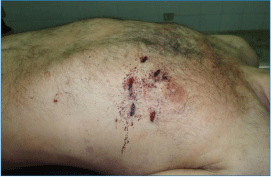
Figure 1: Five horizontal deep wounds in the chest under the left nipple
measuring 2 to 3 cm in diameter.

Figure 2: Two linear abrasions measuring 0.5 to 0.7cm in the left front side
of the chest.
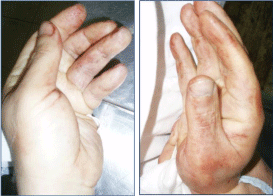
Figure 3: Dry blood traces in both hands without any traumatic lesions.
The autopsy revealed the presence of two wounds in the fourth left intercostal space and three wounds in the sixth one without any rib fractures (Figure 4). A great haemo pneumothorax is found in the left pleural space (3500 ml of blood) (Figure 5). Two deep wounds were found in the lower lobe of the left lung (Figure 5). Moreover a transfixing wound penetrates the left diaphragmatic dome (Figure 6). The stomach contains a blue substance having a particularly irritating smell (Figure 7).
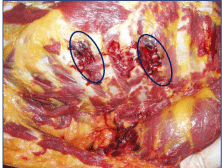
Figure 4: Two wounds in the 4th left intercostal space + three wounds in the
6th left intercostal space.

Figure 5: Left great plenty hemothorax + two deep wound on the lower lobe
of the left lung.
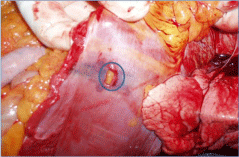
Figure 6: A penetrating wound in the left diaphragmatic dome.
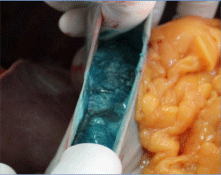
Figure 7: A strange blue substance in the stomach.
Toxicological analysis performed on samples from blood, urine and gastric contents revealed a low serum cholinesterase activity (480IU/L, NV: 3000-8500IU/L) and an anti-cholinesterase pesticide in significant quantities in the stomach.
Discussion
Complex suicide refers to inducing death by a combination of methods. It does not denote only the intricacy of the death mechanism but rather specifies the use of more than one method to induce death. So the term “complex suicide” is highly different from “complicated suicide”. This latter is characterized by unintentional secondary trauma following the original suicide method.
Complex suicide can be divided into two distinct groups: “planned / unplanned” or “primary combined / secondary combined” suicide [6]. If the combination of multiple suicidal methods is previously prepared the suicide is categorized as “planned”. If the failure of the first mechanism brings the victim to come up with an alternative method, the suicide is categorized as “unplanned” [1,7,8].
Victim of complex suicide can use methods of lesser lethality before opting to use more lethal techniques. The conversion from lesser to greater methods of lethality is most likely associated with pain, anguish and frustration [3]. According to the literature victims of complex suicide are young to middle-aged with male sex predominance [2,4,8]. In some cases, various types of psychiatric disorders such as personality disorder, schizophrenia and depression could be revealed in the histories [2,3,4].
Currently, in Tunisia we still don’t have any official statistics on suicide. Nevertheless it is most often committed by hanging [9- 11]. In the forensic literature, complex suicides have been reported to account for about 1.5% to 5% of all suicides [1,2]. Furthermore few studies have concerned complex suicide with self poisoning combined to stabbing [12]. In our case the deceased would have initially swallowed pesticide (anti-cockroach substance) and then he stabbed himself in the chest.
Pesticide ingestion was suspected by the weird smell of the room. Secondarily it was confirmed by the toxicological analysis. Pesticide ingestion is one of the leading suicide methods [13,14]. It accounts for more than one third of all suicide methods each year in the world [14]. It is also known that WHO Class I and II organ phosphorus are the most lethal pesticides in humans [14]. Sometimes, pesticide poisoning poses a problem for the medico-legal diagnosis of death. It may be due to accident, suicide or even homicide [15,16]. At any rate, the variety of pesticides available in communities is large. Some studies suggest that less than 20% of pesticides used for self-poisoning are bought for the purpose and the majorities are freely available in the home or in the workplace [15].
On the other hand suicide by stabbing is extremely rare [17-19]. Multiple stab wounds raise homicide suspicion until proven otherwise [17,20,21]. Although a large number of stab wounds could be found in suicide cases [22,23]. In 2001 Karger and Vennemann report a case of suicide with 92 stab wounds [24]. Other recent suicide cases describe multiple stab wounds in different locations (neck, chest, abdomen...) [25-28]. However in every case of fatal sharp-weapon injuries a set of arguments is necessary to distinguish between homicide and suicide [12,17]. According to the literature, as in our case, the medico-legal diagnosis of suicide is only possible by confrontation of data collected from the autopsy findings, the results of toxicology analysis, the study of the circumstances and the study of the scene of death. We summarize the factors revealed by the literature as factors in favor of suicide hypothesis to:
(1) The circumstances preceding death: suicide note, depression, suicide attempts, marital, social or financial problems... [17,19,29];
(2) The lack of disorder in the scene and the presence of blood limited to the area of the body [17];
(3) The unclothed stabbed area [19-21];
(4) The wound transverse arrangement associated with the suitable position of the wrist during self-stabbing [30-33];
(5) The rarity of rib injuries in case of chest stabbing [9,17,21];
(6) The variable depth of stab wounds [9,34];
(7) The presence of hesitation lesions (tentative cuts) on the wrists or near the target wound [17,20,33];
(8) The presence of dried blood on the hands of the victim without any defense injuries [35];
(9) The presence of toxic (alcohol, drugs …) revealed through toxicological analysis [12,36].
Conclusion
In case of complex suicide the presence of several different injuries can be suspicious as indicating homicide. The study of the circumstances, a careful inspection of the scene of death, a full autopsy and a systematic toxicology analysis are necessary to elucidate the correct mode of death in such cases.
References
- Racette S, Sauvageau A. Planned and unplanned complex suicides: a 5-year retrospective study. J Forensic Sci. 2007; 52: 449-452.
- Bohnert M. Complex suicides. In: Tsokos M, ed. Forensic Pathology Reviews. Totowa, NJ: Humana Press Inc. 2005; 2: 127–143.
- Taff ML, Boglioli LR, Danto BL. Planned complex suicide. Am J Forensic Med Pathol. 1998; 19: 194.
- Cingolani M, Tsakri D. Planned complex suicide: report of three cases. Am J Forensic Med Pathol. 2000; 21: 255-260.
- Marcinkowski T, Pukacka-Sokolowska L, Wojciechowski T. Planned complex suicide. Forensic Sci. 1974; 3: 95-100.
- Palmiere C, Risso E, van Hecke O, La Harpe R. Unplanned complex suicide by self-strangulation associated with multiple sharp force injuries: a case report. Med Sci Law. 2007; 47: 269–273.
- Viel G, Schroder AS, Puschel K, Braun C. Planned complex suicide by penetrating captive-bolt gunshot and hanging: case study and review of the literature. Forensic Sci Int. 2009; 187: 7–11.
- Bohnert M, Rothschild MA. Complex suicides by self-incineration. Forensic Sci Int. 2003; 131: 197–201.
- Ben Khelil M, Allouche M, Banasar A, Shimi M, Gloulou F, Benzarti A, et al. Le suicide par arme blanche dans le nord de la Tunisie : etude sur 8 ans et revue de la literature. J Med Leg Droit Med. 2011; 54: 277-284.
- Allouche M, Banasar A, Gloulou F, Zhioua M, Hamdoun M. Le suicide par pendaison au nord de la Tunisie : aspects epidemiologiques et constatations autopsiques. J Med Leg Droit Med. 2007; 50: 336-342.
- Allouche M, Banasar A, Ben Khelil M, Shimi M, Bekir O, Gloulou F, et al. Le suicide du sujet age au Nord de la Tunisie. J Med Leg Droit Med. 2010; 53: 68-74.
- Dogan KH, Demirci S, Deniz I. An unusual complex suicide by corrosive ingestion and stabbing. Case Reports in Clinical Pathology. 2014; 1: 8-13.
- Gunnell D. The global distribution of fatal pesticide self-poisoning: systematic review. BMC Public Health. 2007; 7: 357.
- Gunnell D, Eddleston M. Suicide by intentional ingestion of pesticides: a continuing tragedy in developing countries. Inter J of Epide. 2003; 32: 902-909.
- Bertolote JM, Fleischmann A, Eddleston M, Gunnell D. "Deaths from Pesticide Poisoning: Are we lacking a global response?" British Journal of Psychiatry. 2006; 189: 201-203.
- Cherin P, Voronska E, Fraoucene N, De Jaeger C. Acute toxicity of pesticides in human. Medicine & Longevite. 2012; 4: 68-74.
- Kaliszan M. Multiple severe stab wounds to chest with cuts to the ribs. Suicide or homicide. J of Forensic & Leg Med. 2011; 18: 26-29.
- Start RD, Milroy CM, Green MA. Suicide by self-stabbing. Forensic Sci Int. 1992; 56: 89-94.
- Karger B, Niemeyer J, Brinkmann B. Suicides by sharp force: typical and atypical features. Int J Leg Med. 2000; 113: 259-262.
- Abdullah F, Nuernberg A, Rabinovici R. Self-inflicted abdominal stab wounds. Injury 2003; 34: 35-39.
- Mazzolo GM, Desinan L. Sharp force fatalities: suicide, homicide or accident? A series of 21 cases. Forensic Sci Int. 2005; 147: 33-35.
- Marx AM. Die Bedeutung von Verletzungs be funden fur die Frage “Selbstmord oder Mord”. Dtsch Z Ges Gerichtl Med. 1923; 2: 412-421.
- Fekete JF, Fox AD. Successful suicide by self-inflicted multiple stab wounds of the skull, abdomen and chest. J Forensic Sci. 1980; 25: 634-637.
- Karger B, Vennemann B. Suicide by more than 90 stab wounds including perforation of the skull. Int J Leg Med. 2001; 115: 167-169.
- Lieske K, Puschel K, Bussmann E. Suizid durch 120 Bruststich verletzungen? Arch Kriminol. 1987; 180: 143-149.
- White DT, Chrostowski L. Suicide by extraordinarily numerous blade wounds. Proceedings of the 62nd AAFS Annual Meeting, Seattle, WA. 2010; 6.
- Pradipkumar Singh Kh, Keisham S, Rishilu K, Meera Devi Th. Suicidal Death due to Stabbing: A Case of Rare Occurrence. J Indian Acad Forensic Med. 2014; 36: 434-436.
- Austin AE, Guddat SS, Gilbert JD, Byard RW. Multiple injuries in suicide simulating homicide: Report of three cases. J of Forensic and Leg Med. 2013; 20: 601-604.
- Demirci S, Dogan KH, Erkol Z, Deniz I. A series of complex suicide. Am J Forensic Med Pathol. 2009; 30: 152-154.
- Karlsson T. Homicidal and suicidal sharp force fatalities in Stockholm, Sweden: orientation of entrance wounds in stabs gives information in the classification. Forensic Sc Int. 1998; 93: 21-32.
- Viel G, Cechetto G, Montisci M. An unusual case of suicide by sharp force. Forensic Sci Int. 2009; 184: 12-15.
- Polson CJ, Gee DJ, Knight B. The essentials of forensic medicine. 4th edtn. Oxford: Pergamon Press: 1985; 125-127.
- Pal Singh V, Sharma BR, Harish D, Vij K. A critical analysis of stab wound on the chest. JIAFM. 2004; 26: 77-79.
- Reddy KSN. The essentials of Forensic Medicine and Toxicology. Mechanical injuries; 2010.
- Brunel C, Fermanian C, Durigon M, de la Grandmaison GL. Homicidal and suicidal sharp force fatalities: autopsy parameters in relation to the manner of death. Forensic Sci Int. 2010; 198: 150-154.
- Olajossy M, Wysocka A, Chuchra M. Study of an atypical suicidal attempt. Arch Med Sad Krym. 1985; 35: 252-254.